The Independence Seaport Museum is a maritime museum that focuses on the Port of Philadelphia and the Delaware Bay. Exhibits explore a variety of subjects, from disasters, immigration and trade to deep sea exploration.
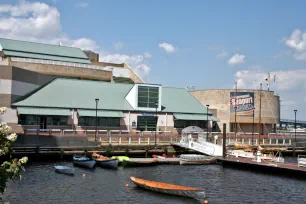
The museum is housed in a modern building on Penn’s Landing, historic Philadelphia’s waterfront. Museum visitors can also climb aboard two warships that are moored nearby: the cruiser Olympia and the submarine Becuna.
History
The Independence Seaport Museum was founded in 1960 as the Philadelphia Maritime Museum. As the museum expanded, it moved to a large premise in the historic center. Meanwhile, the museum had opened a boatyard on Penn’s landing. In the 1990s, it was decided it made sense to move the museum to this location on the Delaware riverfront.
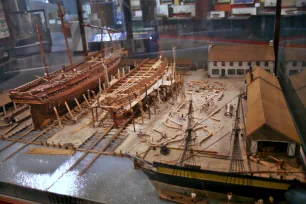

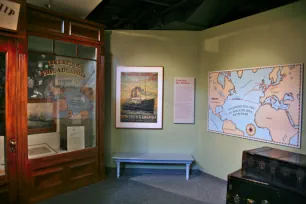
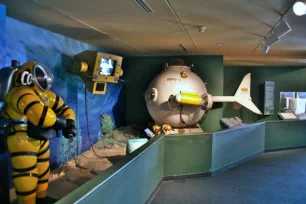

A thorough modernization and expansion of the building started in 1994 and the following year the museum reopened here as the Independence Seaport Museum.
Exhibits
Most of the museum’s exhibits are located on the ground floor. The exhibits are thematically arranged to show different aspects of Philadelphia’s maritime history through the display of ship models, old photographs, posters and nautical objects such as navigational instruments.
The first exhibit visitors encounter is ‘Bound for Philadelphia’, where you walk underneath a huge model of the Benjamin Franklin Bridge. Displays show how sailors found their way on the Delaware River to Philadelphia with the help of navigational charts and instruments.
Nearby, displays in the ‘Home Port Philadelphia’ exhibit illustrate the history of Philadelphia as a booming immigrant and port city. ‘Ship Via Philadelphia’ shows the history of trade and cargo handling. Visitors can even activate a miniature crane to unload cargo. The growing traffic on the waterways also resulted in a fair number of accidents and catastrophes, which are the focus of ‘Disasters on the Delaware River’.
Philadelphia is also the focus of the ‘Coming To America’ exhibit, where you can see the steerage compartments in which many immigrants travelled on their way to the New World. Philadelphia was one of the main destinations for immigrants coming from Europe. A less pleasant aspect of the country’s history is highlighted in the ‘Tides of Freedom’ exhibit, which covers the enslavement of Africans in the New World.
A completely different but fascinating exhibit is ‘Divers of the Deep’, where you can see some of the diving suits and miniature submarines that have been used for deep sea exploration since Alexander the Great used a diving bell in the fourth century BC to explore the bottom of the Mediterranean. Also on the ground floor there is the ‘Workshop on the Water’, an actual workshop where you can observe craftsmen while they are building and repairing boats.
On the second floor are several more permanent exhibits that explore marine-related themes. ‘On the rivers, on the shores’ details the history of small boats; the museum has quite a few of such craft on display. In the same room is ‘What floats your boat’, which uncovers the science behind boat building. Finally, there’s an exhibit devoted to the cruiser Olympia. The actual ship is moored outside and can also be visited.
Warships



A couple of warships moored along the quay are maintained by the Independence Seaport Museum and can be visited. The largest is a cruiser that served in the Spanish American War while the smaller submarine was built during the Second World War. Both ships are National Historic Landmarks.
The Olympia
The USS Olympia is a cruiser that was built in 1892 during a time when the fledgling country was growing in confidence and belligerence. The cruiser gained fame as the flagship of Commodore George Dewey in the Battle of Manila Bay during the Spanish-American War of 1898.
The ship later served as a training ship during the First World War, and in 1918 it was part of an international expedition in Russia against the Bolshevik Red Army. In 1921 the ship transported the remains of an unknown soldier who died in France during the First World War back to the United States, where he was entombed in the Tomb of the Unknown Soldier in Arlington National Cemetery.
The Olympia was decommissioned in December the following year and became a National Historic Landmark in 1964. You can visit the ship’s interior including the rather luxurious officers’ quarters, the sleeping quarters, kitchen and bridge. You can also inspect the ship’s massive guns from up close.
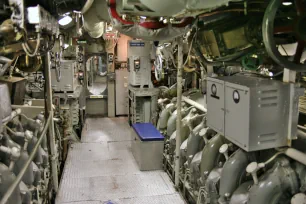
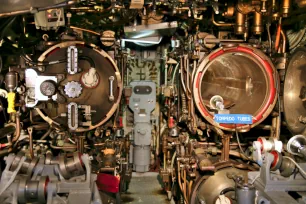
The Becuna
The USS Becuna, a Balao-class submarine, was built in 1994 and served until the end of the Second World War as a flagship in the Southwest Pacific under the command of general Douglas MacArthur. In 1951 the submarine was modernized and modified into a Guppy-class submarine, which resulted in a higher speed and better underwater maneuverability. The Becuna served in the Atlantic until 1969, when it was decommissioned. It was declared a National Historic Landmark in 1986.
Visitors can climb aboard the submarine and walk through all the cramped spaces, including the crew’s mess, sleeping quarters, engine rooms and the torpedo rooms where you can see the impressive torpedo tubes.

